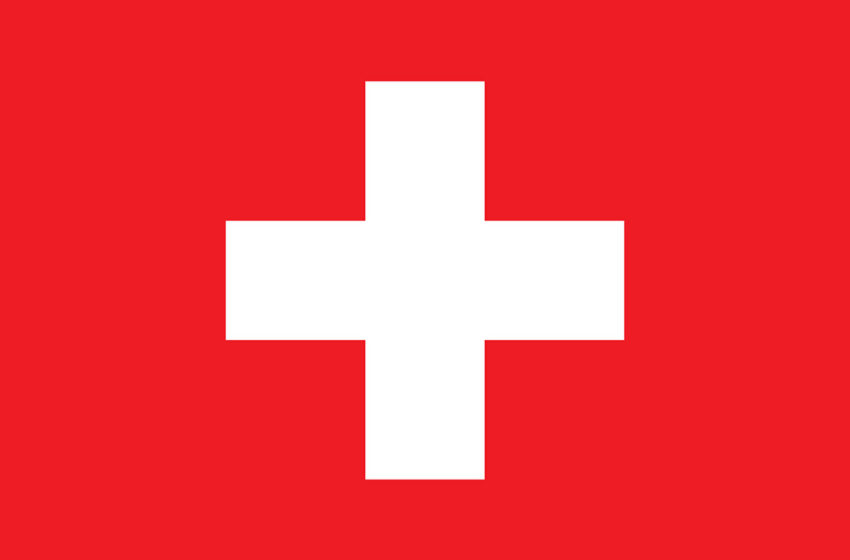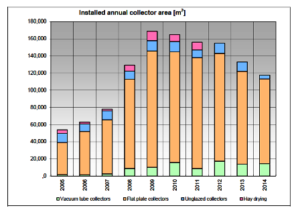In 2015, the solar collector area newly installed in Switzerland shrunk by 16 % compared to 2014. Imports outperformed domestic production, and larger systems for multi-family and commercial buildings, particularly those with vacuum tubes, have gained market shares. These are some of the key findings of the annual study published by the Swiss Federal Office of Energy (see attached study in German and French). Some cantons will completely halt incentives for solar heat because of budget restrictions.
Whereas installations of photovoltaic systems rose by 11 %, the situation for solar heating and cooling is rather discouraging: In 2015, there were 6,700 new solar thermal systems installed in Switzerland compared to almost 9,000 in 2014. The decline, which brought the newly installed collector area down by 16 % to 98,000 m², is somewhat smaller than the number of installations due to large-scale installatiions. Of the 6,075 flat plate collector systems, 13 were larger than 100 m² and 31 had between 51 and 100 m². Of the 565 vacuum tube systems, 7 were larger than 100 m². “We see an on-going trend toward large-scale plants for multi-family buildings and commercial applications, mostly equipped with vacuum tubes,” David Stickelberger from Swissolar said.
The decline was most visible in the drop in flat plate collectors (-23 %), although they remain the dominant type of technology in Switzerland. This year, their import outweighed domestic production. Stickelberger attributes the market imbalance to the growing role of large heating system providers, such as Buderus and Viessmann, in the Swiss solar market. “This shows that solar thermal has become something normal and no longer requires a specialised company,” was his interpretation. In addition, a major Swiss manufacturer of flat plate collectors, Soltop, has experienced difficulties, fuelling the decline in domestic sales. According to the World Map of the Solar Thermal Industry, the company lowered collector production from 25,000 m² in 2013 to 15,000 m² in 2014.
| Collector type |
Area in 2013 (m²)
|
Area in 2014 (m²)
|
Area in 2015 (m²)
|
Difference 2014/2015
|
| Glazed flat plate |
107,962
|
98,744
|
76,275
|
-23 %
|
| Vacuum tubes |
14,012
|
14,403
|
15,485
|
8 %
|
| Unglazed |
5,990
|
3,265
|
4,112
|
26 %
|
| Unglazed, selectively coated |
4,962
|
1,222
|
2,564
|
110 %
|
| Total |
132,926
|
117,634
|
98,436
|
-16 %
|
Overview of three different market studies from the Swiss Federal Office of Energy
In contrast to flat plate collectors, selectively coated unglazed collectors more than doubled in number last year, albeit figures are still half of what they used to be in 2013. It is difficult to interpret the data of such small markets, as they depend on few companies and products. The recent growth could mostly be attributed to sales metal absorbers by Energie Solaire, Stickelberger said. New technologies, such as ice storage or geothermal probes, might stimulate the use of low-temperature collectors, but the next years will have to show if this actually happens or if the changes turn out to be statistical fluctuations. According to Stickelberger, the aforementioned metal absorbers were very suitable for roof integration because of their design, which made them an attractive choice for architects.
Switzerland’s solar thermal policy strategy remains in the dark
In regard to policies, there are two significant changes underway for solar heating and cooling. One concerns the building regulations: The Swiss Conference of Cantonal Energy Directors agreed on nationwide model rules for
building energy regulations in early 2015, but now these rules need to be incorporated into cantonal law. The Jura canton has already completed this process, whereas Berne has adopted some of the rules, with the remaining ones coming into effect in January 2017. In Lucerne, a draft for a new bill is waiting for approval by parliament. The Uri canton started the process, but postponed it because of homeowner associations revolting against stricter obligations for buildings and a ban on electrical heating. Other cantons have been waiting for the federal parliament to decide on the Energy Strategy 2050, which should be approved by early 2017 (see below). Stickelberger said that he expected the new regulations based on the model rules to be in effect in most cantons by 2020, although they might be abandoned in others because homeowners and similar interest groups would not go along with the changes.
The second item on the agenda is the
Harmonised Incentive Model (Harmonisiertes Fördermodell, HFM). This model sees incentives for solar thermal energy rise to about 20 % of the total investment cost. They should entail a basic incentive plus another one calculated based on collector output (details in German, French and Italian: kollektorliste.ch). Owners of systems larger than 30 m² will be required to meter solar yields. The cantons agreed to have the model come into effect in 2017, but because of a change in federal law, they are now grappling with a tighter budget and have been cutting their expenses. The cantons Zug and Zurich will end solar heating and cooling incentives entirely from 2017 on. Stickelberger said he expected other cantons to follow suit.
The long-term funding outlook of the cantons will depend heavily on the Energy Strategy 2050, which is viewed as a necessary step toward fulfilling the Paris climate goals. The current draft stipulates an increase in carbon tax, which would result in the cantons having more money available to spend on energy efficiency projects. Instead of today’s CHF 300 million limit, the budget would add up to CHF 450 million a year. If the bill is approved, the cantons will probably adopt the new incentives for solar heat based on the above-mentioned HFM, as some of the money would be reserved exclusively for energy efficiency measures in buildings. A decision by parliament is expected for 30 September and if approved, the bill will come into force in January 2018.
More information:
More information on the Swiss solar heating and cooling market, policies and potential will be available at the
Tagung Solarwärme Schweiz 2016, organised by Swissolar and suissetec and held on 24 November in Lucerne.



